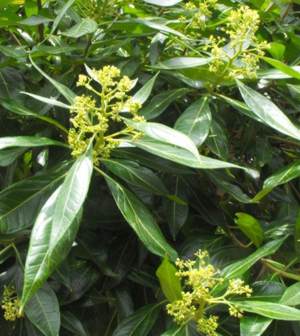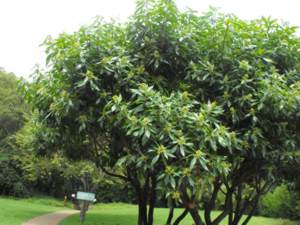Heteropyxis canescens
Heteropyxis canescens Oliv.
Family: Heteropyxidaceae
Common names: forest lavender tree (Eng.); boslaventelboom (Afr.); inkunzana (Siswati)
SA Tree No: 454
Introduction
The forest lavender tree is an evergreen to semi-deciduous, attractive small tree. It deserves to be utilised more in gardens and landscapes, due to its ease of cultivation, small size and versatility.

Description
Description
Heteropyxis canescens is an evergreen or semi-deciduous, small tree, that grows up to 5 m high. Its stem has an attractive, pale orange, patchy bark. The leaves are large, shiny, dark green above and paler green underneath, covered with greyish hairs below. In winter the leaves turn purple-red and maroon giving the tree a distinctive appearance. The flowers are small, yellow-green and appear in dense clusters on terminal heads, which attract butterflies and other insects. The fruit is a small, spherical, pale brown capsule about 3 mm in diameter, enclosed in the dried calyx.

Conservation Status
Status
Heteropyxis canescens is a somewhat rare species with a small distribution range, but is not threatened and is assessed as Least Concern (LC) according to the Red List of South African Plants.
Distribution and habitat
Distribution description
This rare plant is hardy, and occurs in forests and forest margins in a limited range. It is confined to Mpumalanga and northern Swaziland, where it grows in semi, moist conditions alongside streams.
Derivation of name and historical aspects
History
The species epithet canescens refers to ashen-grey, alluding to the colour of the hairs covering the branches and undersides of leaves. The family Heteropyxidaceae has three species in southern Africa, namely Heteropyxis canescens, H. dehniae and H. natalensis.

Ecology
Ecology
Heteropyxis canescens is a valuable, small shade tree and is often conspicuous growing next to streams. It grows reasonably fast and does not have a very aggressive root system, can tolerate some frost and can also survive infrequent drought, but does not flourish in extremely dry areas. Although it prefers full sun it also grows well in shade. This species is restricted to moist places in mountainous habitats. The flowers attract bees, wasps and butterflies. Flowers are small and open-faced which suggests that most small insect pollinators would be capable of effecting pollination of this species while collecting nectar and/or pollen.
Uses
Use
This species has no recorded ethno-botanical uses. However, other species in the genus have been recorded to be used for medicinal purposes. There is equally very little evidence that this species has been used in horticulture for ornamental purposes. The yellow-greenish flowers attract butterflies and insects to the garden, while the attractive bark is a striking feature that can be effectively highlighted by using up-lights shining into the tree at night.
Growing Heteropyxis canescens
Grow
Heteropyxis canescens is an evergreen and attractive plant that can be planted in a garden bed. The fine seed should be sown as fresh as possible in a finely sifted seedling mixture in spring and kept moist and partly shaded; germination takes approximately three to four weeks; seedlings can be planted into individual containers in a well-drained potting mixture once they are large enough to be planted out (approx. one–two years of age onwards). This species comes from warm, moist areas of southern Africa; as such it is not accustomed to extreme conditions of heat, drought or cold. It can be used for the commercial landscape, or in the home garden where it gets regular and frequent water during the summer months; in colder parts of the country it can be planted in a more sheltered position and given protection from severe frost especially when young. The species is moderately fast growing and may reach a mature height of 5 m in as many years, if given sufficient water.
References
- Coates Palgrave, K. 2002. Trees of southern Africa. Struik, Cape Town.
- Pooley, E. 1993. The complete field guide to trees of Natal, Zululand and Transkei. Natal Flora Publication Trust, Durban.
- Van Wyk, B. & Van Wyk, P. 1997. Field guide to trees of southern Africa. Struik, Cape Town.
- Victor, J.E. 2005. Heteropyxis canescens Oliv. National Assessment: Red List of South African Plants.
Credits
Kgabo Moabelo and Andrew Hankey
Walter Sisulu National Botanical Garden
October 2014
Plant Attributes:
Plant Type: Tree
SA Distribution: Mpumalanga
Soil type: Sandy, Loam
Flowering season:
PH:
Flower colour: Green, Cream
Aspect: Full Sun, Shade, Morning Sun (Semi Shade), Afternoon Sun (Semi Shade)
Gardening skill: Easy
Special Features:
Horticultural zones








Rate this article
Article well written and informative
Rate this plant
Is this an interesting plant?
Login to add your Comment
Back to topNot registered yet? Click here to register.